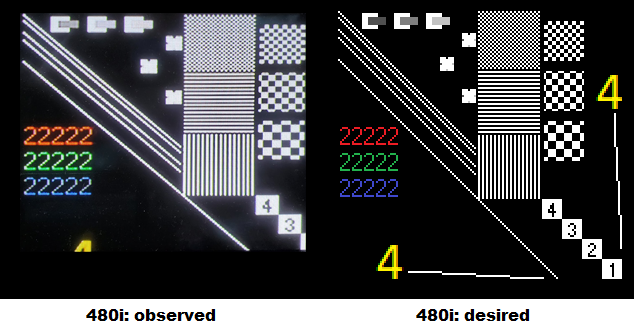Polaroid FLM-373B review: input lag and upscaling tested using the piLagTesterPRO
This 720p TV from 2007 is rather mediocre, with variable input lag, aliasing, and in general very little to recommend it for gaming, retro or otherwise. Edward Land should be tossing in his grave that the once-innovative Polaroid name gets attached to junk like this.
Overview/Image quality
At native resolution (720p) this TV doesn't look that great - it crops 40 pixels off the left and right side of the screen (and also about 20 off the top and bottom). Who knows what the actual resolution of the screen is, as after throwing away that many pixels the screen still has bad aliasing (see photo of 1x1 pixel checkerboards at right).Surprisingly, if you give it 1080p/i it actually looks smoother than 720p, with less jaggies, though of course any fine detail is blurred away, since the panel resolution is fairly close to 720p (probably it's 1366x768).
It has all the standard inputs, including 1 HDMI, VGA, and 2 yPbPr. All test results were identical for HDMI and YPbPr.
Input Lag
This display does not have a game mode; not even a game 'color' preset. In fact there are zero display quality settings to toggle, just the standard brightness/contrast/color, etc. adjustments.
I used a piLagTesterPRO to measure input lag. This device sends a frame of video over HDMI and measures how long it takes to display it.
Complicating things significantly, this is yet another display that does not actually sync to the input signal - instead it fills its own internal frame buffer from the video input and then draws that with a fixed additional delay that is randomly determined each time you turn on the set or switch inputs. The maximum draw rate is 59.94hz, so 60hz (or the "supported" 75hz) just drops frames in order to keep up. At least there's no drift in the input lag for 59.94hz signals. Of zero relevance to gamers but still notable, it can draw the display at 50hz when given a 50hz signal (no doubled frames). So it might be good for watching movies.
Because of the lack of proper sync each time you turn on a new input you'll get a different amount of input lag. To take one example, input lag for 720p will vary from 20ms to 36ms. What you get seems to be entirely up to chance. I've elected to report the average lag values here, since that seems fairest, but there's no right answer; for more discussion of this issue see the above link.
Full Test Results
I report two kinds of values. 1st response measures how long it takes for the TV to start responding (I use a 5% change in display brightness). This overly optimistic value doesn't tell how long it takes to see anything useful, but matches what other reviewers call input lag. full response is a more realistic measure of lag, and requires the display to reach 80% of full brightness. This combines both input lag and response time, and is closer to what you would actually experience in a game.Results compared to other displays
If it weren't for the variable lag this TV would be pretty decent, since recall that on a good day it can start to respond after only 20ms , better than many TVs listed here. But the average lag is more representative, and once you add in the response time this TV is on the slow end of average at best. The 480i results are particularly bad, too.
Conclusion
Other models (to avoid)
I tested the FLM-373B model, which is the 37" version. They also made a FLM-323B and FLM-263B. Based similarities in their names, I suspect they would perform similarly just with smaller pixels. The manual also mentions the FLM-2632, FLM-3232 and FLM-3732, showing then with the exact same specs, including weight and dimensions, so I suspect this was sold with custom model numbers for different stores (so that for instance, Best Buy didn't have to price match with Walmart, or something). However, I've made no efforts to check, so that's only a quick guess.




Comments